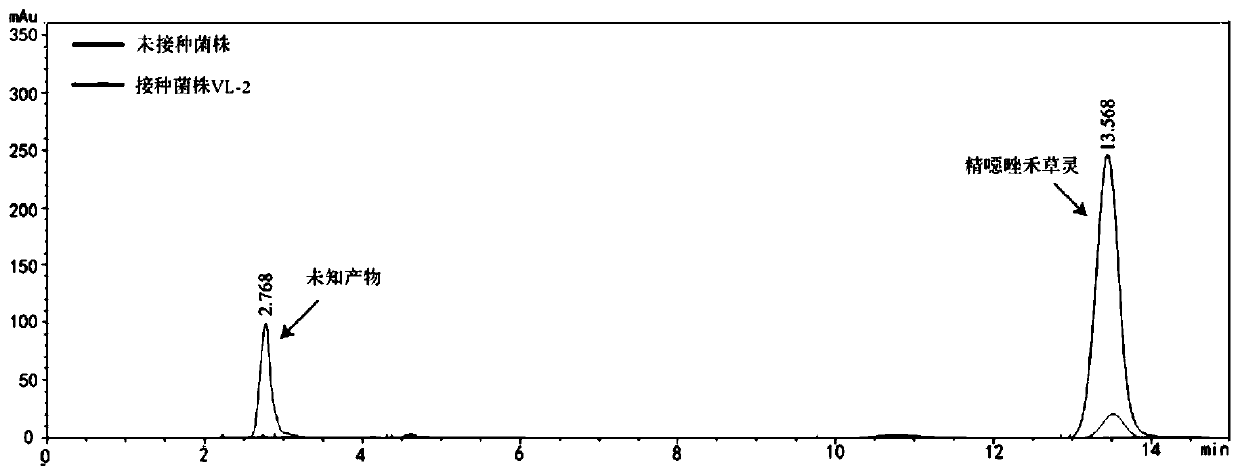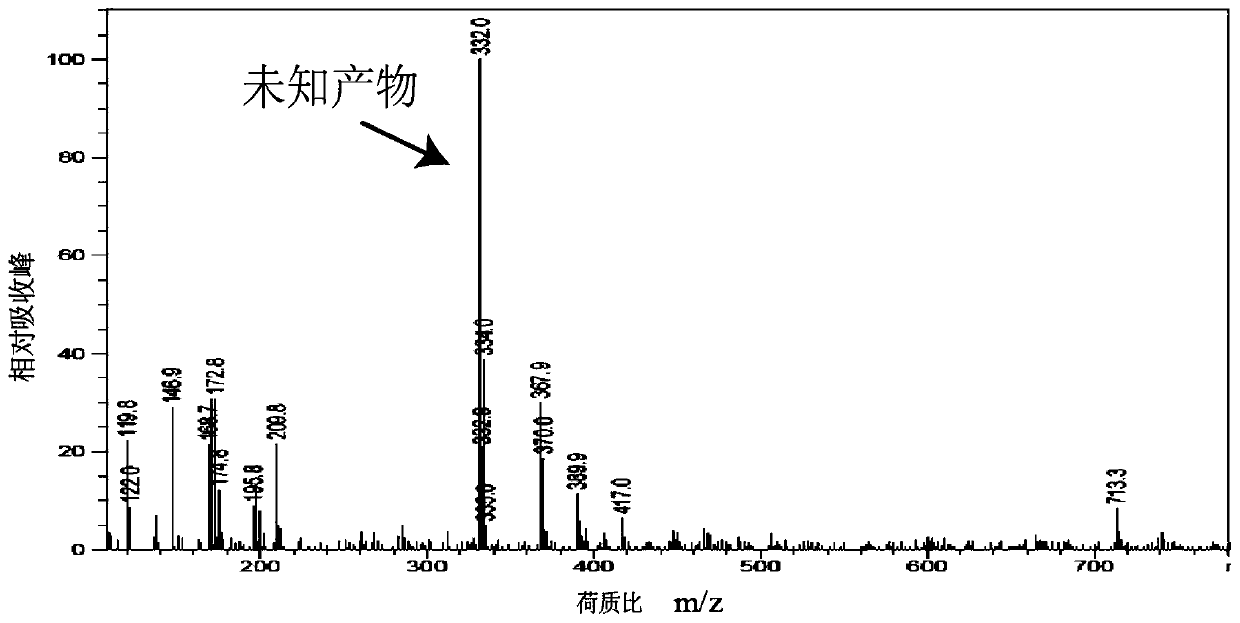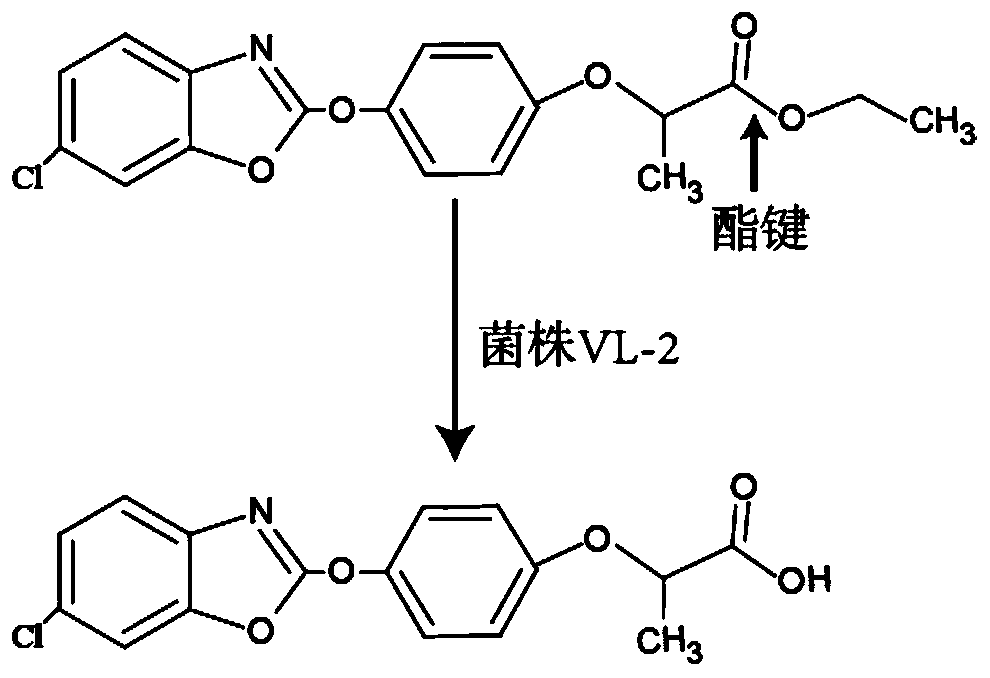An aryloxyphenoxypropionic acid herbicide-degrading strain and its application
An aryloxyphenoxypropionic acid and herbicide technology, which can be applied to bacteria, microorganisms, microorganisms, etc., can solve the problems of narrow degradation spectrum, weak degradation ability of AOPP herbicide, ecological pollution, etc., and achieve the effect of rich degradation spectrum.
- Summary
- Abstract
- Description
- Claims
- Application Information
AI Technical Summary
Problems solved by technology
Method used
Image
Examples
Embodiment 1
[0042] Aryloxyphenoxypropionic acid herbicide degrading strain Acinetobacter sp. Isolation and screening of VL-2:
[0043] Take 2 g of the sludge sample from the sewage discharge outlet of the pesticide factory and place it in 100 mL of inorganic salt medium containing 20 mg / L fenoxaprop-ethyl, at 30 °C, 180 r min -1 Cultured for 5 d. Use the ultraviolet scanner to measure the degradation situation of the enriched liquid to fenoxaprop-ethyl, after confirming that fenoxaprop-p-ethyl is degraded, the culture solution in the inorganic salt medium is inserted into the 50 mg / L fenoxaprop-p-ethyl in the inorganic salt medium, continue to enrich and measure the degradation, follow this method until the concentration of fenoxaprop-p-p-ethyl is increased to 100 mg / L, and pass passage 3 times.
[0044] The enrichment solution with the degradation performance of fenoxaprop-p-p-p was serially diluted and spread on the inorganic salt medium plate with 100 mg / L oxaprop-p-p-p-p as the so...
Embodiment 2
[0048] Aryloxyphenoxypropionic acid herbicide degrading strain Acinetobacter sp. Identification of VL-2 and its growth characteristics:
[0049] 16S rDNA identification of strain VL-2:
[0050] Using primers 27F: 5`-AGAGTTTGATCCTGGCTCAG-3` and 1492R: 5`-TACCTTGTTACGACTT -3` to amplify the 16S rDNA of strain VL-2, connect it to the cloning vector pMD19T by T / A cloning, and construct the recombinant cloning vector pMD19T- 16S, which was transformed into the cloning host strain Escherich coli DH5α obtained from recombinant microorganisms Escherich coli DH5α (pMD19T-16S), the obtained exogenous fragment of the recombinant microorganism was sequenced, and the 16S rDNA sequence was compared with the NCBI database, and the strain VL-2 was identified as Acinetobacter at the molecular level.
[0051] Growth characteristics of strain VL-2:
[0052] Acinetobacter sp. VL-2 is a Gram-negative bacterium that grows very quickly on LB plates. At 30°C for 12 hours, it can form sli...
Embodiment 3
[0054] This example illustrates the optimal growth conditions for strain VL-2.
[0055] Will Acinetobacter sp. VL-2 colonies were inoculated into liquid LB medium at 20, 25, 30, 37, 42°C; pH 4, 5, 6, 7, 8, 9, 10, 11; salt concentration 0 g L -1 , 2 g L -1 , 4 g L -1 , 6 g L -1 , 8 g L -1 , 10 g L -1 , 12 g L -1 , 16 g L -1 , 20 g L -1 ;Measure the OD600 value after shaking culture for 12 hours under the conditions of 10%, 20%, 30%, 40%, 50%, 60%, and 70% of the medium loading volume to determine the optimum fermentation conditions.
[0056] Wherein, the LB medium formula is: peptone 10.0 g·L -1 , yeast powder 5.0 g·L -1 , NaCl10.0 g·L -1 , pH 7.0, sterilized at 121°C for 20 min.
[0057] The optimum growth temperature of strain VL-2 is 30°C, and it can grow well at 25-42°C, but its growth is slightly inhibited at lower temperatures (20°C and 25°C). Bacterial strain VL-2 grows well when the pH is between 5-11, and its optimum growth pH is 7; The growth decreased ...
PUM
| Property | Measurement | Unit |
|---|---|---|
| diameter | aaaaa | aaaaa |
Abstract
Description
Claims
Application Information
 Login to View More
Login to View More - R&D
- Intellectual Property
- Life Sciences
- Materials
- Tech Scout
- Unparalleled Data Quality
- Higher Quality Content
- 60% Fewer Hallucinations
Browse by: Latest US Patents, China's latest patents, Technical Efficacy Thesaurus, Application Domain, Technology Topic, Popular Technical Reports.
© 2025 PatSnap. All rights reserved.Legal|Privacy policy|Modern Slavery Act Transparency Statement|Sitemap|About US| Contact US: help@patsnap.com



